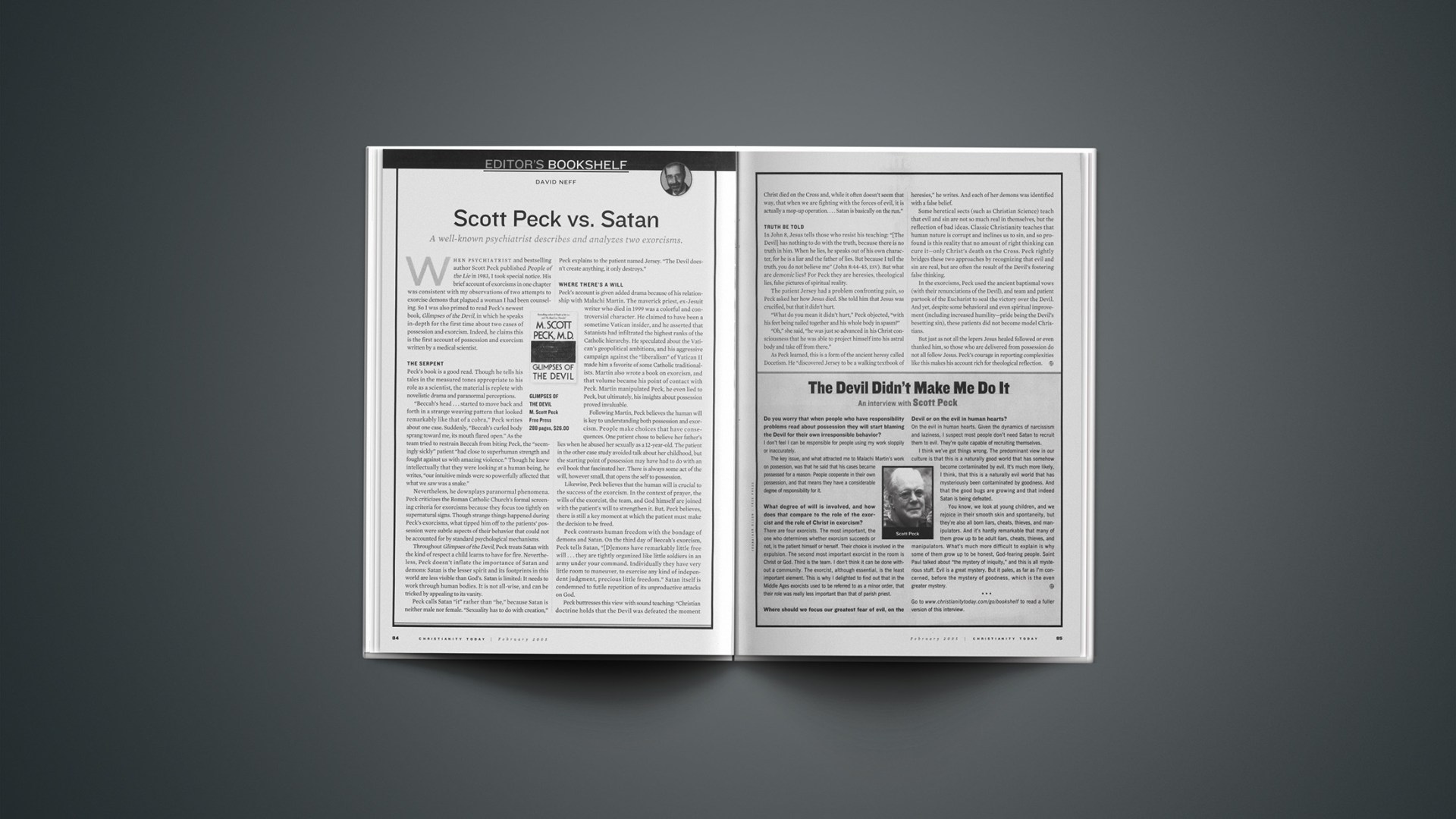| THE DEVIL” width=”100″ height=”153″>GLIMPSES OF THE DEVILby M. Scott PeckFree Press,288 pp.; $26.00 |
When psychiatrist and bestselling author Scott Peck published People of the Lie in 1983, I took special notice. His brief account of exorcisms in one chapter was consistent with my observations of two attempts to exorcise demons that plagued a woman I had been counseling. So I was also primed to read Peck’s newest book, Glimpses of the Devil, in which he speaks in-depth for the first time about two cases of possession and exorcism. Indeed, he claims this is the first account of possession and exorcism written by a medical scientist.
The Serpent
Peck’s book is a good read. Though he tells his tales in the measured tones appropriate to his role as a scientist, the material is replete with novelistic drama and paranormal perceptions.
“Beccah’s head … started to move back and forth in a strange weaving pattern that looked remarkably like that of a cobra,” Peck writes about one case. Suddenly, “Beccah’s curled body sprang toward me, its mouth flared open.” As the team tried to restrain Beccah from biting Peck, the “seemingly sickly” patient “had close to superhuman strength and fought against us with amazing violence.” Though he knew intellectually that they were looking at a human being, he writes, “our intuitive minds were so powerfully affected that what we saw was a snake.”
Nevertheless, he downplays paranormal phenomena. Peck criticizes the Roman Catholic Church’s formal screening criteria for exorcisms because they focus too tightly on supernatural signs. Though strange things happened during Peck’s exorcisms, what tipped him off to the patients’ possession were subtle aspects of their behavior that could not be accounted for by standard psychological mechanisms.
Throughout Glimpses of the Devil, Peck treats Satan with the kind of respect a child learns to have for fire. Nevertheless, Peck doesn’t inflate the importance of Satan and demons: Satan is the lesser spirit and its footprints in this world are less visible than God’s. Satan is limited: It needs to work through human bodies. It is not all-wise, and can be tricked by appealing to its vanity.
Peck calls Satan “it” rather than “he,” because Satan is neither male nor female. “Sexuality has to do with creation,” Peck explains to the patient named Jersey. “The Devil doesn’t create anything, it only destroys.”
Where There’s a Will
Peck’s account is given added drama because of his relationship with Malachi Martin. The maverick priest, ex-Jesuit writer who died in 1999 was a colorful and controversial character. He claimed to have been a sometime Vatican insider, and he asserted that Satanists had infiltrated the highest ranks of the Catholic hierarchy. He speculated about the Vatican’s geopolitical ambitions, and his aggressive campaign against the “liberalism” of Vatican II made him a favorite of some Catholic traditionalists. Martin also wrote a book on exorcism, and that volume became his point of contact with Peck. Martin manipulated Peck, he even lied to Peck, but ultimately, his insights about possession proved invaluable.
Following Martin, Peck believes the human will is key to understanding both possession and exorcism. People make choices that have consequences. One patient chose to believe her father’s lies when he abused her sexually as a 12-year-old. The patient in the other case study avoided talk about her childhood, but the starting point of possession may have had to do with an evil book that fascinated her. There is always some act of the will, however small, that opens the self to possession.
Likewise, Peck believes that the human will is crucial to the success of the exorcism. In the context of prayer, the wills of the exorcist, the team, and God himself are joined with the patient’s will to strengthen it. But, Peck believes, there is still a key moment at which the patient must make the decision to be freed.
Peck contrasts human freedom with the bondage of demons and Satan. On the third day of Beccah’s exorcism, Peck tells Satan, “[D]emons have remarkably little free will … they are tightly organized like little soldiers in an army under your command. Individually they have very little room to maneuver, to exercise any kind of independent judgment, precious little freedom.” Satan itself is condemned to futile repetition of its unproductive attacks on God.
Peck buttresses this view with sound teaching: “Christian doctrine holds that the Devil was defeated the moment Christ died on the Cross and, while it often doesn’t seem that way, that when we are fighting with the forces of evil, it is actually a mop-up operation. … Satan is basically on the run.”
Truth Be Told
In John 8, Jesus tells those who resist his teaching: “[The Devil] has nothing to do with the truth, because there is no truth in him. When he lies, he speaks out of his own character, for he is a liar and the father of lies. But because I tell the truth, you do not believe me” (John 8:44-45, ESV). But what are demonic lies? For Peck they are heresies, theological lies, false pictures of spiritual reality.
The patient Jersey had a problem confronting pain, so Peck asked her how Jesus died. She told him that Jesus was crucified, but that it didn’t hurt.
“What do you mean it didn’t hurt,” Peck objected, “with his feet being nailed together and his whole body in spasm?”
“Oh,” she said, “he was just so advanced in his Christ consciousness that he was able to project himself into his astral body and take off from there.”
As Peck learned, this is a form of the ancient heresy called Docetism. He “discovered Jersey to be a walking textbook of heresies,” he writes. And each of her demons was identified with a false belief.
Some heretical sects (such as Christian Science) teach that evil and sin are not so much real in themselves, but the reflection of bad ideas. Classic Christianity teaches that human nature is corrupt and inclines us to sin, and so profound is this reality that no amount of right thinking can cure it—only Christ’s death on the Cross. Peck rightly bridges these two approaches by recognizing that evil and sin are real, but are often the result of the Devil’s fostering false thinking.
In the exorcisms, Peck used the ancient baptismal vows (with their renunciations of the Devil), and team and patient partook of the Eucharist to seal the victory over the Devil. And yet, despite some behavioral and even spiritual improvement (including increased humility—pride being the Devil’s besetting sin), these patients did not become model Christians.
But just as not all the lepers Jesus healed followed or even thanked him, so those who are delivered from possession do not all follow Jesus. Peck’s courage in reporting complexities like this makes his account rich for theological reflection.
Copyright © 2005 Christianity Today. Click for reprint information.










